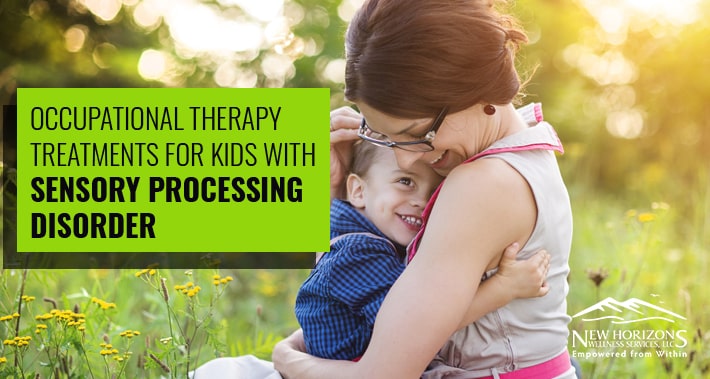
Does your child react adversely to the feel of certain fabrics on their skin? Or really dislike foods with a strong smell or taste? When a child is unable to respond to sensory inputs in ways which most people would consider “normal”, it may be a sign of a sensory processing disorder.
We are New Horizons Wellness Services and one of the services we offer is occupational therapy for kids with sensory processing disorder. Keep reading to learn more about sensory processing disorder, how to recognize it, and ways an occupational therapist can help.
What Is Sensory Processing Disorder?
When a child has difficulty responding to sensory inputs, it could be a sign of sensory processing disorders. This means that they may be averse to inputs such as sound, touch, light, taste, or smell. Children with sensory processing disorder may resist physical contact such as hugs, or display hyperactive behavior. Sensory processing has to do with the ways in which we perceive the world and goes beyond the “Five senses” of touch, taste, smell, sight, and hearing.
It also includes things like bodily awareness, spatial recognition, and understanding of how the body “feels” – in both the literal sense, such as distinguishing hot and cold, as well as feeling emotions. Little is known about this disorder or the best methods of treatment, in large part because many doctors and experts in childhood development believe it is a component of other conditions.
What Are The Symptoms Of Sensory Processing Disorder?
The way sensory processing disorder presents in children can vary depending on the way different children process the world around them. In some, it may result in hypersensitivity and being easily stimulated. These children may have difficulty when in a brightly lit space or surrounded by excess noise.
Other signs of this may include:
- Clumsiness
- Covering ears or eyes
- Being a “picky eater”
- Low tolerance for pain
- Attempts to flee situations without regard for safety
Conversely, children who have low sensitivity to stimuli may attempt to engage more with the world in order to get sensory feedback. Those who are sensory hyposensitive may:
- Crash into people and bump into walls
- Have a higher pain threshold
- Touch things they shouldn’t
- Put things into their mouths
- Enjoy giving hugs
What Causes Sensory Processing Disorder?
The exact cause of sensory processing disorder isn’t known and is often thought to be a symptom of other issues rather than something which occurs on its own. Conditions which are often linked to sensory processing disorder include attention deficit hyperactivity disorder, autism spectrum disorder, and obsessive compulsive disorder. There is some evidence to suggest it may have a genetic component and may be more prominently displayed in children with anxiety. Another explanation could be abnormalities of the brain which affect the response to stimuli.
Furthermore, children who were born prematurely or experienced complications during birth seem to be more likely to have sensory issues than their peers.

What Does An Occupational Therapist Do?
Occupational therapists work with ill, disabled, or injured people – both children and adults – to help them recover the ability to perform everyday activities. In particular, when working with children, an occupational therapist can help support the development skills which for a variety of reasons may not be developing at the same rate as their peers. They will perform an evaluation to determine the specific issues your child is facing, and then offer a treatment plan designed to help address these issues.
How Can An Occupational Therapist Help With Sensory Processing Disorder?
There is no one standard treatment for sensory processing disorder. However, occupational therapists can help by identifying sensory issues and having children perform activities which can help them better regulate their reactions to inputs.
Some techniques which may be used to help with this regulation include:
- Using tactile input with a variety of textures to increase tolerance for “typical” exposure to touch sensations.
- Sensory gym: Providing structured movement experiences through swinging, spining and otherwise move around in a safe space with padded surfaces
- Rolling or bouncing on large balls
- Jumping in a ball pit
- Sensory Diet: Activities developed to help a child get stimulation, which may include: foot massage, use of a mini-trampoline, pushing a cart, drinking cold water, activities designed to promote balance, and eating crunchy or chewy foods.
When the right treatments for your child are in place, you will generally notice increased focus and a sense of calm in your child.
Book An Appointment With New Horizons Wellness Services
Do you have a child who hates bright lights or can’t stand being in a room with loud noises? Have you suspected that there might be more to the reasons why your child is a “picky eater”? Are they hypersensitive to stimuli, or dislike being hugged? It’s possible you might be dealing with a sensory processing disorder. Here at New Horizons Wellness Services, we can help diagnose and provide treatment for your child’s unique sensory needs. Contact us today to set up a consultation, or to learn more.

Yours in Health,
New Horizons Wellness Services13333 SW 68th Pkwy,
Tigard, OR 97223
- https://g.page/newhws
New Horizons Wellness Services provides a true multidisciplinary approach to mental & physical health treatments for children, adults and families.